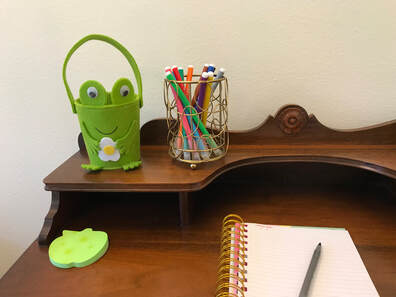 Where will your kids do their schoolwork at home during distance learning or for after school homework? Take a few minutes to reflect on your family’s needs and physical set up to help with a smooth start to the school year. Choosing a location: Begin by considering the following... -How many people need to be working simultaneously at the home (adults and kids)? -Does each person need to be in a separate room or can they work in the same room? -How much supervision does each person need? -What helps each person to focus and what is most distracting to each? Creating a spot: Start with a traditional desk or table with a chair. This is the main space that your student will use. Make sure that they have access to everything that they will need, not just pencils, paper, pens, headphones, charger, and extension cord, but also supplies like flashcards, hole puncher, stapler, scissors, markers, paper, and glue. Add general items like a garbage can, recycling container, coaster for a drink of water, and charging station. Mobile Supplies: Create a way for your kids to be able to easily move their school supplies with them if they change locations. A plastic caddy works well for containing school supplies. You could also use a backpack, basket, bin, or cart. Include all of the supplies that they may need (see the above section). In addition, if you are using a multi-use space, like the kitchen table, for daily school, then it is even more important to be able to put everything away at the end of each school day. While you're at it, you can tidy up your desk, too! Give your Child Options:
If it’s possible, create several spaces in which your child can do virtual school. Add a “comfy” choice for learning, such as a spot on the floor with pillows, a couch, or a lounge chair. Consider also offering an outdoor work location if at all possible: a balcony, porch, or in the yard. During the school day, allow kids to move around within their set “learning locations”. As long as they are working, not distracting others, and are not in danger, lean towards letting them do it. When you are setting up the spaces, you can ask your child to weigh in on the decisions. This can be as simple as allowing them to decide how to arrange the pillows on the floor, which color headphones to purchase, or which favorite stuffed animal they would like to put on their desk to “decorate”. Rationale: Having choices is a very important part of learning. Research on learning and the brain tell us that giving students choices increases both their engagement and their attention (Assessment, Choice, and the Learning Brain by Glenn Whitman). In other words, students are much more likely to do what they are asked to do if they are also given some choice in the matter. Teachers provide choices by allowing students to choose from several topics, pick how they would like to present their research, or even decide in which order they would like to complete several tasks. As a kid, there are so many things that are not a choice; as a parent, try to give your kids choices whenever possible, even if it’s simply choosing the order in which to do A and B. By having options for where your child can choose to sit while learning, attending online classes, or completing assignments, you are giving your child some autonomy and control over their day. This can be a powerful positive force when so many things feel out of control. KonMari™ Your Space! Looking for some inspiration from Marie Kondo? Check out her short video geared towards students to help them imagine and create their ideal study space! Take some time to discuss your set up with your family and then get started! Remember that none of this is permanent, and you can rearrange the furniture or supplies any time. So go set something up and then allow room for adjustments as you see how things work when school is in session. Let me know if you have any questions or would like to schedule a consult! Laura Comments are closed.
|
AuthorMy name is Laura, and I love all things organizing! Categories
All
|
 RSS Feed
RSS Feed
